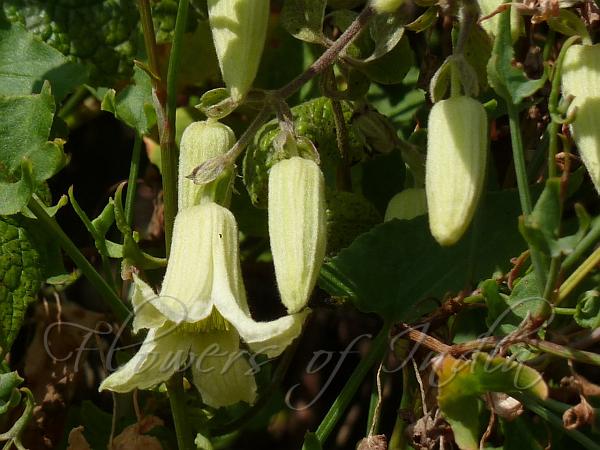|
| Lemon Clematis |
|

|

| File size | 297183 |
| Original date | 10/25/12 3:08 PM |
| Resolution | 1280 x 960 |
| Flash | Flash did not fire, auto |
| Focal length | 49.2mm |
| Exposure time | 1/500s |
| Aperture | 5.6 |
| Focus Distance | |
| Metering Mode | Multi-segment |
| Camera make | Panasonic |
| Camera model | DMC-TZ10 |
| Sensor type | OneChipColorArea |
|
|
|
|
Photo: |
Botanical name: Clematis buchananiana Family: Ranunculaceae (Buttercup family)
Synonyms: Clematis buchananii, Clematis wattii
Synonyms: Clematis buchananii, Clematis wattii
Lemon Clematis is a woody vine with branches
shallowly 8-10-grooved, densely yellowish velvety. Leaves are compound,
carried on 4.5-9 cm long stalks. Leaflet blades are broadly ovate,
ovate, or elliptic, 4-11 cm long, 4-10 cm wide, papery, undivided or
3-lobed, abaxially densely or rarely sparsely pubescent, adaxially
sparsely appressed pubescent, base somewhat heart-shaped to rounded,
margin toothed, tip pointed to tapering. Flowers are borne in cymes in
leaf axils, usually many flowered, paniclelike; peduncle 2-20 cm.
Bracts are leaf-like or simple, ovate to lanceolate. Flowers are
1.5-2.5 cm in diameter, flower-stalk 1-3.5 cm, densely yellowish
puberulous. Sepals are 4, yellow, erect, lanceolate-oblong to narrowly
oblong, 2-3 cm long, 0.5-0.9 cm wide, abaxially densely appressed
puberulous and apically sometimes slightly emarginate, adaxially
sparsely pubescent apically from middle, apex acute to rounded and
often recurved. Stamens are about 1 cm, anthers narrowly oblong to
linear, 2.6-5 mm, glabrous, tip obtuse. Style is 1.3-1.5 cm, densely
villous. Lemon Clematis is found in the Himalayas, from Kashmir to NE,
Assam, N. Burma, Indo-China, W. China, at altitudes of 1800-3300 m.
Medicinal uses: A paste of the roots is used
as a poultice to treat swellings caused by inflammation. The juice of
the root is used in the treatment of peptic ulcers. The juice is also
inhaled to get rid of coughs and colds.
A paste of the stem or root
bark is kept pressed against the teeth for about 15 minutes to relieve
toothache. The juice of the plant is applied externally to cuts and
wounds. It is also taken internally in the treatment of indigestion.
A paste of the roots is used
as a poultice to treat swellings caused by inflammation. The juice of
the root is used in the treatment of peptic ulcers. The juice is also
inhaled to get rid of coughs and colds.
A paste of the stem or root
bark is kept pressed against the teeth for about 15 minutes to relieve
toothache. The juice of the plant is applied externally to cuts and
wounds. It is also taken internally in the treatment of indigestion.
Medicinal uses:
 A paste of the roots is used
as a poultice to treat swellings caused by inflammation. The juice of
the root is used in the treatment of peptic ulcers. The juice is also
inhaled to get rid of coughs and colds.
A paste of the stem or root
bark is kept pressed against the teeth for about 15 minutes to relieve
toothache. The juice of the plant is applied externally to cuts and
wounds. It is also taken internally in the treatment of indigestion.
A paste of the roots is used
as a poultice to treat swellings caused by inflammation. The juice of
the root is used in the treatment of peptic ulcers. The juice is also
inhaled to get rid of coughs and colds.
A paste of the stem or root
bark is kept pressed against the teeth for about 15 minutes to relieve
toothache. The juice of the plant is applied externally to cuts and
wounds. It is also taken internally in the treatment of indigestion.
| Identification credit: Prashant Awale, Gurcharan Singh | Photographed in Dhanaulti, Uttarakhand & GHNP, Himachal Pradesh. |
• Is this flower misidentified? If yes,